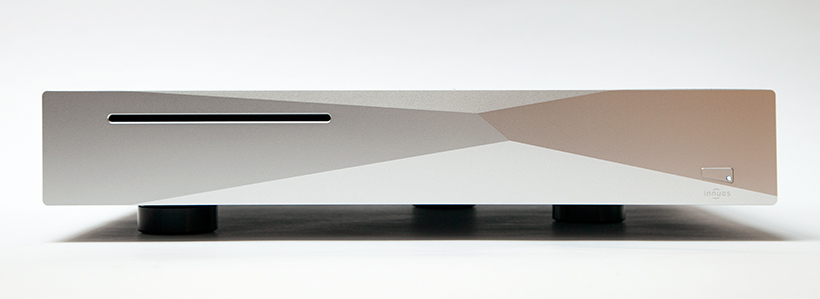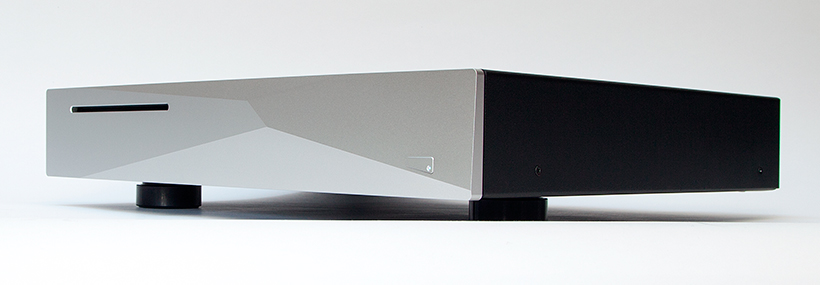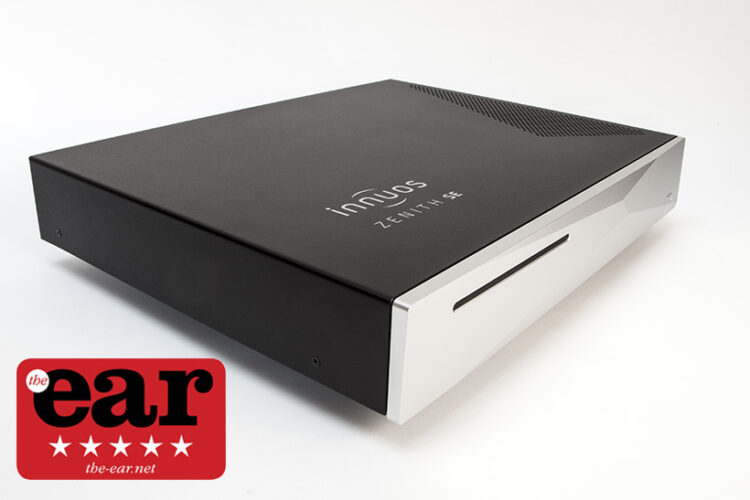Way back in the day, let’s call it the early seventies, a clever Scotsman made it clear that contrary to prevailing theory that loudspeakers were where it’s at, the turntable was in fact the source of the signal and thus the most critical element in the system. He was right and went on to sell a great many turntables as a result. Yet in streaming audio we seem to have forgotten that the source is king, that regardless of how good the elements that follow it are if all the data is not extracted from the media without distortion or corruption, there’s no way of making up for it thereafter. So the most critical element in a streaming system is the drive that contains the data, the bits that describe the music signal. If you have ever compared a dedicated audio server with a NAS drive or a PC you will have some notion of this, but if you heard the Zenith SE it would be totally obvious. As someone who has been using decent audio servers for a few years this server is like a bolt from the blue, a revelation of the gobsmacking persuasion.
Innuos has been making its Zen and Zenith audio servers for a few years now, they are all very good indeed and generally better than the competition at their various price points. They have their foibles of operation but once you get your head around their particular logic it’s easy to use them as a USB or a network source for your digital music library. The SE is a ostensibly a special edition Zenith although it still has the suffix STD to keep us guessing. It has a different coloured fascia and asymmetrically placed and rather more compliant feet but otherwise looks much the same as the ‘standard’ model, the only other clue is that it weighs more. That weight is the result of a new power supply designed for Innuos by Sean Jacobs, a cable maker and power supply specialist from Manchester. Innuos credit much of the SE’s capabilities to this element and when you hear just how quiet this server is it’s easy to understand why, Jacobs himself is more modest and suggests that Innuos themselves have done the lion’s share of the work. Either way I can confirm that this is a highly beneficial collaboration, the SE is by far the quietest and most revealing digital source I have encountered in three decades of reviewing.

It reveals that the crux of apparently noise free digital audio is in fact noise. Which is a bit confusing to say the least, after all the whole benefit of CD was the absence of noise associated with analogue systems. But while it didn’t have tape hiss or the intrinsic character of vinyl neither did digital audio sound natural at birth, and it still falls behind in this most elusive of qualities. I put it down to the calculations required to ‘do the math’, to analyse 16-bits 44,100 times per second, but noise is a byproduct of this processing. Not audioband noise like hiss but high frequency noise that isn’t directly audible but folds down into the audioband in such a fashion as to make it self heard as a coldness. Streaming systems have greatly reduced this perception and generally sound warmer and more relaxed than spinning discs, they also deliver higher bit and sample rate files that push the noise up further, which itself creates a more natural sound. But it wasn’t until I installed the Zenith SE did I realise just how much lower the noise could be, and the transparency that this would produce.
Functionally the Zenith SE is like its more affordable stablemates, it has the same SSD drive of a regular Zenith and can be had in 2TB and 4TB variants. It has a pair of USB A sockets for back-ups and direct to DAC connection and another pair of RJ45 Ethernet ports for network and streamer hook up. The latter means there’s no need for an external switch in the loop, a useful reduction in noisy switched mode power supplies and runs of Ethernet cable. It should be mentioned however that my reference server, the Melco N1A, operates in the same way so no advantage was gained here. Library management is achieved largely via the my.innuos online portal (library view below), just put that into your browser and it will find the Innuos on your network. Then you can fill the library by importing from a NAS, USB drive or via the auto import feature when you access the server on your desktop. You can of course rip your discs themselves to either FLAC or WAV using the Zenith’s slot drive, that is the simplest if slowest approach.

There wasn’t enough space on the review sample to import everything on my NAS so I had the less straightforward job of picking certain artists or albums using all three of the options available. The easiest turned out to be the USB route, so long as your files are reasonably well sorted (tracks need numbers for instance) and stored in artist/album/tracks style this works as expected. The NAS route involves establishing the precise path name for each artist or album and this is not as obvious as it could be, while the auto-import function is fine if you have a wired connection to your PC but painfully slow over wi-fi. However, with perseverance and a bit of support from Innuos I got the hang of it. It all depends on how tidy your digital library is, and mine clearly isn’t! Apparently Innuos has an update coming this month which should make things easier on this front.
Epiphany machine
But the reason I wanted to get as much music as possible onto the Zenith SE is that I have never heard better sound from digital audio before. This despite reviewing some pretty spendy DACs and very tasty streamers over the years, all it turns out were limited by the absence of a good enough source despite me using the best that I could lay my hands on at the time. Most of course were DACs not streamers and while the Zenith has a USB output it didn’t seem to give as good a result as the Ethernet connection in my system. This is not just a choice of plug and socket it’s a push (by the server) or pull (by the streamer) comparison, USB sends a PCM (or DSD) bitstream to the DAC, with a UPnP streamer the entire data file goes to the streamer which unpacks it and sends the audio signal to a DAC. But it’s important to remember that implementation of these processes will have a bearing on the resulting sound, Ethernet will not always sound better than USB.

I listened to the Zenith SE via two streamers, a Naim Uniti Atom and an Auralic Vega G2 (review coming soon) and got the same sense of openness and transparency with both. The Auralic was in the big system and is the more revealing of the two so gave the most melon twisting results but the Naim provided as many epiphanies because I had more time with it. By epiphany I mean moments of sheer unadulterated joy, when tears sprang to my eyes because the music was so moving. Both music that is very familiar and tracks that I tried just to see how they sounded, one of the latter was John Martyn’s live version of ‘Spencer the Rover’ (“At the expense of a raver” as he jokes in the intro) from a BBC In Session release of recordings made between 1973 and ’75. Live recordings benefited the most from the vinyl like openness provided by the Innuos, they have lots of low level information on them so by unveiling this you get a more comprehensive picture of the musical event. So much so that you might as well be there, all it takes is to eliminate the visual element by closing your eyes and it’s so easy to suspend the disbelief that I was carried away time and time again.
With studio recordings what you hear is twice as much as can usually be perceived, it really feels like a doubling of data. Everything becomes so much easier to identify, follow, enjoy and be transported by. This is of course recording dependent, Steely Dan is very popular at the Ear so their best works have been played to death on vinyl. These were the hardest to find new detail within, yet the evenness of tonal balance of digital combined with the absence of vinyl character means that insights can still be found. Equally fascinating is listening to different versions of the same track, especially where high res versions are available. These things have usually sounded better than the CD res alternative but now the difference is blinding, I discovered as much with Joni Mitchell’s Hejira, another favourite, where the high res version is so much more detailed and revealing that the CD rip sounded opaque. Essentially you hear much more of the original sound with this server than I have heard with any other digital system.

Naturally if the recording is not so great that is also clear, Nils Frahm’s fabulous Spaces album of live performances is undermined by some very crude recording methods, including cassette. This is more obvious but the brilliance of the playing is even easier to appreciate, equally important is that distortion is so much lower that you can play at a higher level without discomfort, his ‘Improvisation For Coughs And A Cell Phone’ is sheer perfection. The way that you can hear so far into dense mixes makes it very hard to turn the system off, Frank Zappa made his best music in the first ten years of his ‘career’ but given that they were the late sixties and early seventies recording quality wasn’t always as good as it could be, or so it usually seems. Put something like Apostrophe on the SE however and you can hear what everyone was doing, the mix just opens up and exposes the fabulous nature of the composition and the musicianship. Modern recordings inevitably have the edge when it comes to creating a believable sense of being there, even audience made ones like the 2006 recording of Ryan Adams and the Cardinals Live at Das Haus (free on archive.org). Here it’s the excitement of the audience that is key to the ‘being there’ sense of atmosphere, the noise floor is so low on the SE that you can hear every mumble beneath the aching blues of a musician at his peak, it really is powerfully moving stuff of the sort that you rarely encounter at home.
The Innuos Zenith SE represents a major step forward for audio reproduction, it’s an example that I hope will be imitated far and wide now that Innuos have proved what can be done. I really can’t recommend this product highly enough, the fact that it’s limited to a run of a 100 units is a travesty but I suspect that Innuos will be using this technology in future products, it would be heresy not to. In the meantime I’m moving house and changing phone numbers in an attempt to keep this sample, once word gets out these things will be like gold dust!


